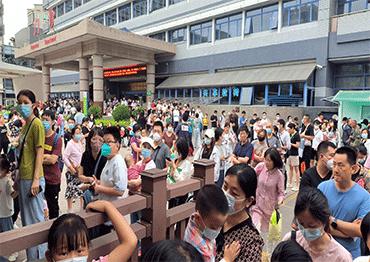In June 2017, Tao wrote in the Chinese Journal of Health Policy that: “The clinical staff’s thoughts and techniques should play a decisive role in the medical field, rather than funding and equipment. Previous reforms have impacted everything but doctors’ enthusiasm, which is the core competence of public hospitals.”
According to Tao, the average wage of doctors in developed countries is usually three to five times the average income. However in China, that proportion remains lower than three.
A survey conducted by Yimi Research in September 2022, which gathered responses from 2,226 participants across the country, showed the average annual income of doctors from clinical work was 94,000 yuan (US$13,243) and 13,000 yuan (US$1,779) from nonclinical work. This is 2.9 times higher than the average income of 36,883 yuan (US$5,049) reported by the National Bureau of Statistics in January. Only 23 percent of respondents reported receiving non-clinical salaries.
The low incomes and demanding schedules have led 34 percent of doctors from the survey to seek new job opportunities. Many are considering positions in foreign or private hospitals, where annual salaries can reach as high as 200,000 yuan (US$27,380).
Liu Yuanli, dean of the School of Health Policy and Management at Peking Union Medical College, highlighted the physical and psychological strain experienced by doctors after 10 years of training, especially surgeons who may spend over 10 hours in the operating theater at a time.
Chinese public hospitals receive funding from a combination of direct government funding, insurance and patient payments.
In July 2021, a guideline issued by five administrations, including the Ministry of Human Resources and Social Security, outlined the merit pay system for public hospitals, which was first instituted in 2006. According to the guideline, doctors’ wages can be increased based on hospital revenues, with the expectation that the majority of revenue will come from medical services. If there is a surplus in the medical insurance accounts after reimbursing patients, it can be allocated as performance pay.
Caught between their public remit and the need to balance the books, Chinese public hospitals over the years have adopted a variety of renumeration models. During the planned economy era, they offered ffxed wages. However, after reform and opening-up in 1978, the cost of medical services soared, partly due to expensive and overprescribed medications as doctors sought commissions from pharmaceutical companies to increase their salaries. Now that this practice has been stopped, doctors’ salaries are based on seniority, with extra subsidies and performance pay tied to the number of patients seen and the number of successful surgeries and recoveries. However, the government’s contribution to doctors’ basic salaries is still far from enough.
Zhang Man, a breast surgeon at a prominent hospital in Guangzhou, capital of Guangdong Province, told NewsChina that her and her colleagues’ salaries are pegged to department revenues, which are distributed regardless of individual workloads. As a result, there are few incentives for doctors to work harder.
At another leading hospital in South China, doctors’ performance pay is closely tied to their workload. “Doctors who are in charge of more patients and hospital beds get higher pay,” Cheng Hao, an associate chief physician at the hospital, told NewsChina.
Public hospital doctors eagerly anticipate the new reforms that aim to make their payment system more flexible and rational.
“The price of many medical services is outdated and needs adjusting,” a chief neurologist at a hospital in Beijing told NewsChina on condition of anonymity.
Zhao Li, a director of emergency surgery at a hospital in Wuhan, capital of Hubei Province, told NewsChina that the patient registration fee at his hospital has been fixed at 5.5 yuan (US$0.75) ever since he started there in 2006. In contrast, other leading public hospitals in Beijing and Shenzhen, Guangdong Province, have already increased the fee to 50-70 yuan (US$6.8-$9.6). High workloads, night shifts and low pay in emergency wards make it hard to recruit young doctors, emergency physician Song Lin from another top hospital in Wuhan told NewsChina.
“The current cost and pay of medical service undervalues doctors’ arduous and professional contributions,” Zhao said.
According to Tao Hongbing, it is reasonable that charges for medical services should generate 60 percent of hospital revenues. However, in China it is about 30 to 40 percent.
In 2017, the government put a stop to hospitals generating extra revenue from hiking the price of prescription medications. They must be sold at the price they are bought for.
Liu argued the policy is throwing the baby out with the bathwater. “Although it curbed price hikes for prescription medicines and lessened the pressure on the medical healthcare insurance fund, the costs of selecting, purchasing, storage and adverse-reaction observations can’t be covered if we can’t raise the price,” he said.

 Old Version
Old Version


